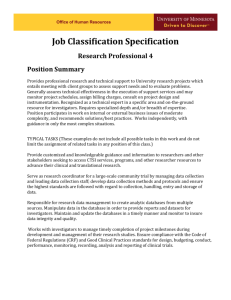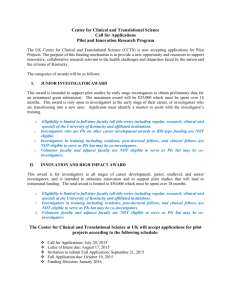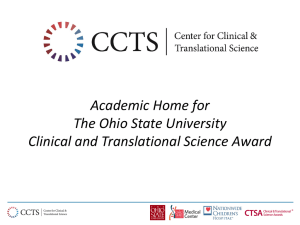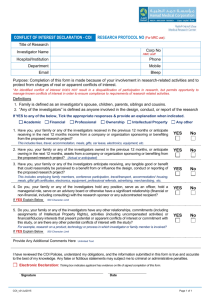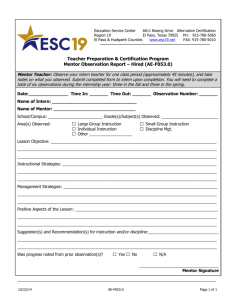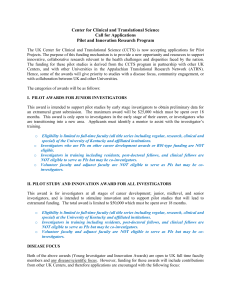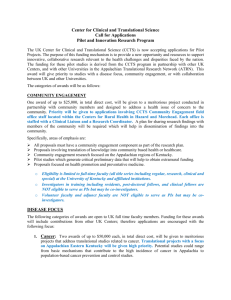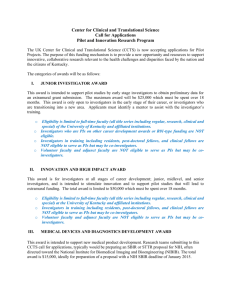limited to 4 pages - Research
advertisement
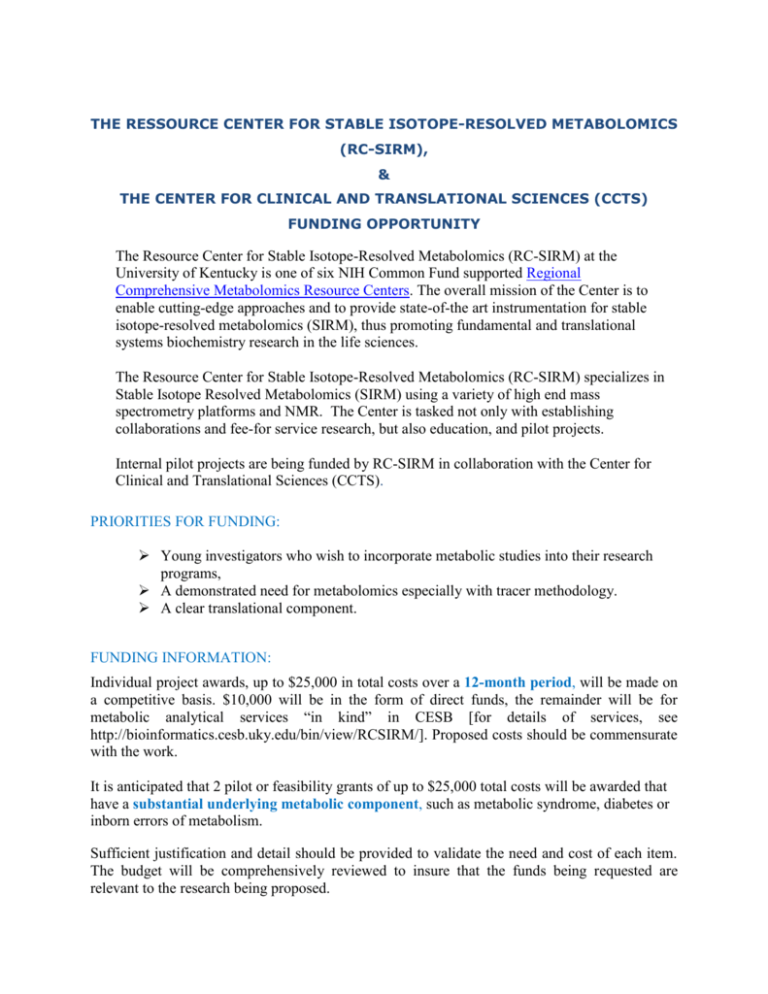
THE RESSOURCE CENTER FOR STABLE ISOTOPE-RESOLVED METABOLOMICS (RC-SIRM), & THE CENTER FOR CLINICAL AND TRANSLATIONAL SCIENCES (CCTS) FUNDING OPPORTUNITY The Resource Center for Stable Isotope-Resolved Metabolomics (RC-SIRM) at the University of Kentucky is one of six NIH Common Fund supported Regional Comprehensive Metabolomics Resource Centers. The overall mission of the Center is to enable cutting-edge approaches and to provide state-of-the art instrumentation for stable isotope-resolved metabolomics (SIRM), thus promoting fundamental and translational systems biochemistry research in the life sciences. The Resource Center for Stable Isotope-Resolved Metabolomics (RC-SIRM) specializes in Stable Isotope Resolved Metabolomics (SIRM) using a variety of high end mass spectrometry platforms and NMR. The Center is tasked not only with establishing collaborations and fee-for service research, but also education, and pilot projects. Internal pilot projects are being funded by RC-SIRM in collaboration with the Center for Clinical and Translational Sciences (CCTS). PRIORITIES FOR FUNDING: Young investigators who wish to incorporate metabolic studies into their research programs, A demonstrated need for metabolomics especially with tracer methodology. A clear translational component. FUNDING INFORMATION: Individual project awards, up to $25,000 in total costs over a 12-month period, will be made on a competitive basis. $10,000 will be in the form of direct funds, the remainder will be for metabolic analytical services “in kind” in CESB [for details of services, see http://bioinformatics.cesb.uky.edu/bin/view/RCSIRM/]. Proposed costs should be commensurate with the work. It is anticipated that 2 pilot or feasibility grants of up to $25,000 total costs will be awarded that have a substantial underlying metabolic component, such as metabolic syndrome, diabetes or inborn errors of metabolism. Sufficient justification and detail should be provided to validate the need and cost of each item. The budget will be comprehensively reviewed to insure that the funds being requested are relevant to the research being proposed. NON-ALLOWABLE COSTS Funds cannot be used to support salary of the Principal Investigator or other investigators with faculty appointments. Funding is not available for thesis or dissertation projects. Funding will not be awarded as bridge funding for ongoing projects. Facilities and Administrative costs: also known as indirect costs are not permitted. In the event that additional intra/extramural funds are secured to support the study outlined in your application you must immediately notify Elodie Elayi ((859) 323-7939, eel222@email.uky.edu). Funds will be held by the CCTS and the budgets invoiced for a period of 12 months maximum, dependent on the nature and scope of the study. Individual principal investigators will not be allowed to hold more than one CCTS pilot research award at any one time. PILOT RESEARCH PROTOCOL SUBMISSION PROCESS APPLICATION INSTRUCTIONS: Applicants are encouraged to review the instructions provided below carefully and to contact Elodie Elayi ((859) 323-7939, eel222@email.uky.edu) with questions. Incomplete or incorrectly prepared applications will be returned without review. Follow the steps below to apply for CCTS pilot research support: For the application, margins must be no smaller than 0.5” at all points. Use an Arial, Helvetica, Palatino Linotype, or Georgia typeface, a black font color, and a font size of 11 points or larger. (A Symbol font may be used to insert Greek letters or special characters; the font size requirement still applies). Type density, including characters and spaces, must be no more than 15 characters per inch. Type may be no more than six lines per inch. EACH page should provide the applicant’s name in the upper right hand corner. The application should be numbered consecutively in the center bottom. *APPLICATIONS SHOULD BE ASSEMBLED IN THE FOLLOWING ORDER* I. Cover Page(s): (not included in the 4 pages limit) 1. Title of the Project and Total Amount Requested. 2. Applicant’s information for Principal Investigators and Co-Investigators : o Name o Degree(s) o Rank, Title (s) o o o o o College Department /Division eRA Commons Username Campus Address, Contact Information including e-mail and telephone number 3. Mentor’s information (Applicable only for junior investigators): Name, Degree(s) and Rank, Campus Address, and Contact Information 4. Applicant’s Chair Information for each collaborator: Name, Campus Address, and Contact Information II. Detailed Budget and budget justification in NIH format, direct cost only** The budget must include a detailed breakdown of the costs of metabolomics analysis including both the instrument time and data analysis if requested. Sufficient justification and detail should be provided to validate the need and cost of each item. The budget will be comprehensively reviewed to insure that the funds being requested are relevant to the research being proposed. Budget must be approved by Elodie Elayi BEFORE submission. Applicants must account for fringe benefit costs when considering research assistant salary levels. NO INDIRECT COSTS ARE ASSIGNABLE THROUGH THIS MECHANISM. The budget template can be downloaded here. III. Body of the proposal: (limited to 4 pages) Specific Aims: (limited to one page) State concisely the goals of the proposed research and summarize the expected outcome(s), including the impact that the results of the proposed research will exert on the research field(s) involved. List succinctly the specific objectives of the research proposed, e.g., to test a stated hypothesis, create a novel design, solve a specific problem, challenge an existing paradigm or clinical practice, address a critical barrier to progress in the field, or develop new technology. The format of the application will follow NIH guidelines as outlined below. State concisely the goals of the proposed research and summarize the expected outcome(s), including the impact that the results of the proposed research will exert on the research field(s) involved. List succinctly the specific objectives of the research proposed, e.g., to test a stated hypothesis, create a novel design, solve a specific problem, challenge an existing paradigm or clinical practice, address a critical barrier to progress in the field, or develop new technology. Research Strategy Organize the Research Strategy in the specified order and using the instructions provided below. Start each section with the appropriate section heading—Significance, Innovation, Approach. Cite published experimental details in the Research Strategy section and provide the full reference in the Bibliography section. Given the length of the application, investigators should strive to provide a relevant, although not exhaustive bibliographic review (described below) (a) Significance Explain the importance of the problem or critical barrier to progress in the field that the proposed project addresses. Explain how the proposed project will improve scientific knowledge, technical capability, and/or clinical practice in one or more broad fields. Describe how the concepts, methods, technologies, treatments, services, or preventative interventions that drive this field will be changed if the proposed aims are achieved. (b) Innovation Explain how the application challenges and seeks to shift current research or clinical practice paradigms. Describe any novel theoretical concepts, approaches or methodologies, instrumentation or intervention(s) to be developed or used, and any advantage over existing methodologies, instrumentation or intervention(s). Explain any refinements, improvements, or new applications of theoretical concepts, approaches or methodologies, instrumentation or interventions. (c) Approach Describe the overall strategy, methodology, and analyses to be used to accomplish the specific aims of the project. Include how the data will be collected, analyzed, and interpreted as well as any resource sharing plans as appropriate. Discuss potential problems, alternative strategies, and benchmarks for success anticipated to achieve the aims. If the project is in the early stages of development, describe any strategy to establish feasibility, and address the management of any high risk aspects of the proposed work. Clearly describe how each partner will be engaged in the development and/or implementation of the pilot study. (Applicable for partnership applications) As applicable, also include the following information as part of the Research Strategy, keeping within the three sections listed above: Significance, Innovation, and Approach. Preliminary Studies. Include information on Preliminary Studies. Discuss the PI’s preliminary studies, data, and/or experience pertinent to this application. Preliminary data can be an essential part of a research grant application and help to establish the likelihood of success of the proposed project. IV. Appendix (not included in the 4 pages): Biosketch in NIH format from PIs, Co-PIs and Mentor: The BIOSKETCH template can be downloaded here. Support for PIs from the partnering universities Protection of human subjects section and animal assurances (if applicable) References- Authors, year, title and journal information is expected for each citation. Given the length of the application, investigators should strive to provide a relevant, although not exhaustive review. (Not more than 2-3 pages) The required endorsement letter from the primary mentor for new investigators (see below), as well as letters from key personnel must be included. Relevant assessment materials may be included if they are of reasonable length and significantly enhance the review of the application. DO NOT submit published manuals, materials in the public domain or similar materials. This is NOT a means of extending the length of the proposal itself. MENTORING AND CAREER DEVELOPMENT PLAN (new investigators): Role and qualification of mentor(s). Inclusion of a clinician (physician, dentist, pharmacist, clinical psychologist, physical therapist, etc.) mentor is highly desirable in studies involving direct interaction with human participants. A career development plan must be in place to enhance clinical and translation research capabilities. This may include didactic coursework, the Clinical and Translational Science Seminar Series, and/or the Translational Science Spring/Fall Conference. MENTOR ENDORSEMENT (new investigators): To facilitate the effectiveness of the CCTS Pilot Research Program in enhancing the research development of newly appointed faculty investigators, new investigators must provide a letter of endorsement and collaboration from a senior investigator who is willing to serve as a mentor for the applicant over the course of the project. This person must possess a M.D., Ph.D., PharmD or other doctoral degree and must have sufficient clinical research expertise to serve as a mentor to the applicant. The letter should reflect the amount of time the mentor is willing/able to direct to this role as well as the specific types of activities that will be involved. These activities should include reviewing progress on the project, reviewing initial data, helping plan for future project funding after the pilot phase, discussing relevant research articles or related activities. It is NOT required that the mentor have funded effort. This letter should be included in the appendix material of the application. LETTER FROM SUPERVISOR/DEPARTMENT CHAIR: A letter signed by the immediate supervisor (e.g. Division Chief) and/or Department Chair that includes acknowledgement of their support for the project and providing assurance that sufficient protected time to complete the research will be available. No specific amount of protected time is required, but the review committee will consider the distribution of effort and other activities of the applicant Timeline Call for Applications: June 26, 2015 Full Application due: July 15, 2015 Funding decision: August 2015
